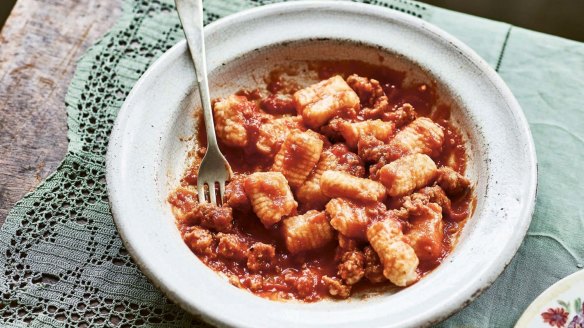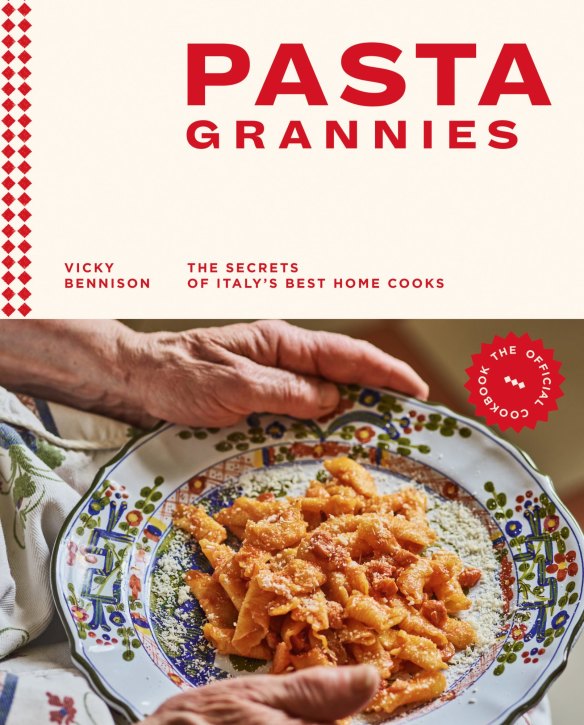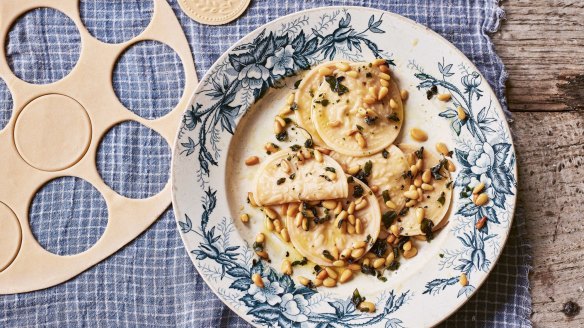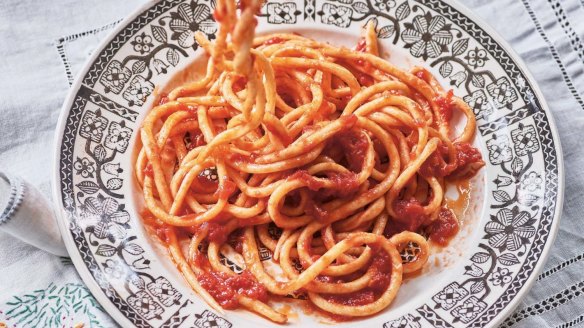Cook like a nonna: Three authentic Italian recipes from Pasta Grannies
Updated , first published

All Italians know their grandmothers are the best cooks. Every nonna has her own recipe; in fact, every nonna has her own recipe for everything. Vicky Bennison's new cookbook brings together the cooking of these women - the Pasta Grannies as she calls them. It features some of the women who have starred on her YouTube channel, which celebrates Italy's best home cooks and their kitchen secrets.
Selvina's gnocchi con salsicce
Serves: 4 people

For many years, Cremona was just one of those signs I saw on the motorway on the way to Milan, too busy worrying about the tailgating speedster behind me to consider visiting. But it's definitely worth a detour: just outside, in a little village scattered along what feels like a Roman road to nowhere, lived Selvina Bertuzzi. She passed away in April 2019. I am most sorry she didn't get to see her story in print. For this recipe, Selvina used to use a type of plain, unspiced sausage common in Lombardy called luganica. It's made without links, so you'll see it presented in a spiral.
INGREDIENTS
For the gnocchi
1kg old, floury potatoes
250g plain (all-purpose) flour
1 egg
For the sauce
1 onion, finely chopped
1 tablespoon extra-virgin olive oil
4 good-quality plain sausages, skins removed
400g tin of tomatoes
salt
To serve
grated parmigiano reggiano
knob of unsalted butter
METHOD
Peel the potatoes and boil them whole or in halves. Leave them to cool just a little before passing the pieces through a potato ricer. Spread the mash out to let it cool further. You want warm, not steaming hot, potato.
Sprinkle the flour over the mash and crack in the egg. Mix it quickly and gently so everything amalgamates. Then stop – this is not like making bread or pasta. On a floured surface, roll the mixture into ropes and cut into pieces the size of large green olives.
In a frying pan (skillet), saute the onion in olive oil until soft but not coloured. Crumble in the sausage meat and smash it down into the onion. Fry it for another couple of minutes and then add the tomatoes. Break up the tomatoes, season with salt and let it bubble down to a chunky sauce. This will take about 20-30 minutes.
When you're ready to cook your gnocchi, bring a large saucepan of salted water to the boil. Warm a serving platter and have it ready. Add the gnocchi to the water – in batches if necessary, depending on the size of your pan as you don't want the gnocchi to be overcrowded. Once they bob to the surface, wait another 30 seconds and then scoop them out with a sieve or slotted spoon. Place on the warmed dish, sprinkle the parmigiano reggiano over the top, then fold through the sauce, followed by a generous knob of butter. Eat immediately.

Franco and Alessandra's corzetti with fresh marjoram dressing
Serves: 6 people
Liguria looks like it has been stapled to the mountains with the motorway that loops down its length, a rumpled shoulder seam of Italy. Its tumbled terrain is inhospitable to mechanised large-scale agriculture, and so market gardeners still flourish. Consequently, Liguria's local food markets have avoided the fate of so many in Italy, with their lacklustre stalls reselling produce from major distributors. We had been given a tour of the town of Chiavari by the totally charming Franco Casoni and his wife, Alessandra. Franco is an acclaimed wood sculptor specialising in figureheads for boats, with a side-line in making stamps for coin-shaped pasta called corzetti.
INGREDIENTS
For the pasta
600g 0 flour or plain (all-purpose) flour (it doesn't need to be the more finely ground 00 flour)
5 egg yolks, plus 1 whole egg, beaten
about 150ml dry white wine (enough to bring the dough together)
For the dressing
100ml Ligurian extra-virgin olive oil or other grassy-tasting olive oil
120g pine nuts
25g fresh marjoram leaves
2 garlic cloves
METHOD
First, make the pasta. Tip the flour onto a pasta board or into a bowl and make a well in the middle. Add the beaten egg yolks plus whole egg. Use a fork to mix the flour into the eggs and then gradually pour in the wine. Bring the dough together. Knead until it is smooth and silky. This will take about 10 minutes. Cover the dough with a tea towel (or put it in a lidded bowl) and leave it to rest for at least 15 minutes.
Keeping the board, pin and dough well floured, roll out the dough until it is about the same thickness as a foil-wrapped chocolate coin (3mm). As Alessandra explains, if you roll the dough too thinly the patterns from the two sides of the stamp will cancel each other out.
If you have a stamp, use the cup end of the cylinder block to stamp out the circles in the dough with a twisting motion – it's the same as cutting scone or cookie dough. Place the disc on the engraved end of the stamp block and press down with the handle. The result will be a double-sided embossed corzetto. Repeat until you have used all the dough. If you don't have a stamp, use a small glass or cookie cutter.
Bring a large pan of water to a rolling boil, add a teaspoon of salt, return the water to a boil and shovel in the pasta. Cook for 4 minutes, until the pasta tastes cooked and feels firm and not soggy to bite. Drain.
While the pasta is cooking, warm the oil in a small pan and add the pine nuts, marjoram and garlic. Leave them to bathe in gentle bubbles for 4 minutes. Keep a close eye on the pan, as you don't want the pine nuts to burn, but they can turn a little golden. Remove the garlic cloves and pour the dressing over the pasta. Eat immediately.

Giuseppina's pici with garlic tomato sauce
Serves: 4 people
Giuseppina Spiganti is 93 years old. She is something of a local treasure, as she is the last surviving member of the group which began a pici sagra, a local food festival, 50 years ago. The village of Celle sul Rigo had a marching band, which was in need of money, so a sagra, celebrating the local pasta, pici, was born.
INGREDIENTS
For the pasta
400g 00 flour or plain (all-purpose) flour
pinch of salt
1 egg
about 165ml water semolina flour, to roll the pici in for the garlic sauce
For the sauce
4 tablespoons extra-virgin olive oil
5 garlic cloves, ones that have not developed their "anima" or green shoots
fresh red chilli peppers, to taste (Giuseppina used one, sliced into three)
2 tablespoons tomato paste
400g plum tomatoes, preferably San Marzano
salt
METHOD
The sauce has to simmer for a couple of hours, so start this before your pasta. Pour the olive oil into a small saucepan – it should cover the base to a depth of 5mm. Warm up the oil over a low heat and saute the whole garlic cloves until you can crush them with a spoon; they shouldn't burn. This will take about 20 minutes. About 15 minutes into the cooking, add the chilli pepper, and continue frying the two ingredients for the final 5 minutes. Stir through the tomato puree, followed by the plum tomatoes. Break up the tomatoes with a wooden spoon, season with salt, and add half a tin of water. Let this simmer very gently over a low heat for 2 hours, adding a splash of water from time to time if you need to. You want a thick sauce at the end. Giuseppina uses a food mill to puree the sauce – to make sure the garlic and chilli disappear. You could also use a hand-held blender.
Make the pasta dough as described below but swap 3 of the eggs for water. Fill a shallow bowl with semolina flour to drop your pici into, to stop them from sticking together. Place a small bowl of water to the side of your pasta board, so you can keep your fingers moist while rolling the dough into pici (or use a small spritzing bottle filled with water).
Roll the dough out quite thickly, about 5mm. Then slice it up, making 1 × 12cm batons. Take each one, place it on the board and place both your hands together over the pasta. Keep your fingers straight and roll out the pasta, moving your hands apart. You are creating a spaghetti strand, so try and keep the pasta even in thickness. Giuseppina's pici are much slimmer than some of the tubby versions you see on the internet; aim for about 3mm in diameter and 40cm long.
Drop your finished pici into the semolina. If the bowl starts getting a little crowded, move them onto a tray.
Bring a large pan of salted water to the boil and drop the pici in. Cook for 2 minutes and then test for doneness. Drain and stir through the sauce – you want it to cling to the pasta and not puddle around it. Serve immediately. Traditionally, no cheese is added.
How to make egg pasta dough
The nonna way is to decide on how many eggs you are going to use, and use one handful of flour for every egg. This handful equates to 100g of flour per egg.
Step 1: Weigh out your ingredients
Allow 100g 00 flour (or plain/all-purpose flour) per person for a main course-sized portion. You need 55g egg without its shell for every 100g flour.
For example, if you are making pasta for four people, you will need 400g flour and 220g egg, which most of the time will mean four hen eggs. But weighing out your ingredients means you can also use other eggs, such as duck or turkey, which is something the nonne do.
If your eggs are on the small side, add a bit of water or another egg yolk to bring the quantity up to the right weight. If your weight is slightly over, use the egg shell to scoop out excess egg white.
Step 2: Mix them together
Tip the flour onto your board in a heap. Use your fingers to make a well in the centre, making sure it's not too wide or the rim too low, otherwise your egg mix will overflow.
Pour the eggs into the well. Take a fork (or use your fingers) and scramble the eggs together. They are mixed sufficiently when you lift the fork and you have a homogeneous, non-clumpy looking liquid that falls smoothly from your fork.
Draw your fork round the inside of the flour wall, so a small quantity of flour falls into the egg mixture. Whisk it in, smooshing any lumps, so you gradually create a batter. Repeat until you have a mixture that won't run all over the board. At this point you can cave in the flour walls and mix in the rest of the flour with a bench scraper by scraping the flour inwards and over the batter. Of course, you can beat the egg and flour together in a bowl, even with a food mixer, but it's not as fun.
Mop up any flour with your dough and give it a quick knead. If it is sticky, add a tablespoon of flour and knead it in. It is better to adjust your dough now than later.
If it is not sticky and you have some flour on the board, scrape off the excess, so you have a nice clean board to knead your dough. Nonne sieve any excess flour and reuse it.
The dough should feel soft and pillowy, but not too sticky.
Step 3: Knead the dough
Knead the dough for 10 minutes minimum. Think of your hands as waves: the heels of your hands push the dough away from you, while your fingers pull it back. Once your dough has become a log, turn it 90-degrees and fold it half and continue kneading. You want to work at a brisk pace, as air is the enemy of decent pasta – it will dry it out, so don't dawdle. If the pasta feels too dry, damp your hands with water to put moisture back into the dough.
Kneading develops the gluten and elasticity of the dough. Your dough should feel silky and smooth. When you press your thumb into the dough, it should bounce back. Some nonne judge their dough to be done when they can see small holes in the dough if sliced through the middle. To knead, you can also use a dough hook on your food mixer.
Step 4: Leave the dough to rest
At this point, place the dough in a lidded bowl and cover it to stop it from drying out. Cling film (plastic wrap) is good too, but you may not want to use it. You can also use a tea towel, but it's important it hasn't been washed with perfumed detergent as this will add an odour to your pasta. Leave the dough at room temperature for 30 minutes. This relaxes the gluten and makes it easier to roll out.
You can also leave it in the fridge overnight.
The colour will darken, but it will taste the same. It's important to bring the pasta back to room temperature before you try rolling it.
Step 5: Roll out the dough
Nonne all have their own technique for rolling out. Some smooth out the dough over their pin with a dowager breast stroke in varying degrees of stateliness; others approach it with all the intensity of a curling team scrubbing ice in front of their stone. Whatever the sporting analogy, it's most definitely an upper arm workout. Those in Emilia Romagna pride themselves in being able to roll a perfect circle. This isn't necessary but it looks gorgeous.
Julia Ficara, who runs handmade pasta classes in Rome at her cookery school Grano e Farina, recommends the following technique because it's efficient and back-friendly. This is wordy – but watching the Pasta Grannies "How to Roll Pasta" video on YouTube will help bring this explanation to life.
Before you start, remember to keep your pasta floured throughout the process.
Cup your hands over your rolling pin so your wrists nearly touch the pasta board. Flatten your dough with your pin, turning it a few degrees at a time in the same direction; this helps to keep it circular.
When it is the size of a plate, start with your hands at hip width and roll the top third of your dough (furthest away from you) by following the curve of the circle and drawing your hands inwards as you push the pin away from you. Your hands will meet in the middle. Stop the pin before it reaches the very edge. Roll the dough four times.
Turn the pasta from 12 to one and repeat going round the clock.
You will end up with a bump of pasta in the middle. To get rid of it, flip the outer edge of pasta over the pin. Hold the pasta with one hand, and place the other hand on the dough to stop it moving. Give the pin a tug with the pasta hand to create a snug fit around the pin. Roll the dough over the pin towards you.
Move your hands wider, stick your elbows out and, pressing down, roll the pasta out two or three times. This will flatten the thicker central zone of your pasta. Finish with the pasta rolled up and turn it 90 degrees, opening it out across the board.
Repeat this process until the sfoglia (the sheet of pasta) is too large to move comfortably by hand. At this stage, you will need to roll it up around the pin and turn it, as described above. Allow your pin to roll on its own across the dough to remove any air after you have turned it.
You can let your sfoglia drape over the edge of the board – allow about a third, no more, otherwise the whole thing will slip off. This helps to anchor and stretch it, but also it means you don't have to stretch too far over the board, messing up your back. Remember not to lean against the pasta.
Do not attempt to roll the entire sheet (until you feel expert) or change rolling direction; just keep rolling the outer third directly in front of you. As the dough gets bigger, your arms and elbows start quite far apart. Eventually, you will end up with pasta you can see through. It should feel like heavy linen.
To check your pasta is evenly rolled, roll up a third, hold onto the edges (it will fall off the pin otherwise) and hold it up to the light. Darker patches mean thicker dough and you haven't rolled it uniformly, so you will want to go back over these areas.
Leave your pasta sheet to dry on the board for 5 minutes. For tagliolini, tagliatelle and pappardelle, you can now flour it, roll it up very gently (like a carpet) into a log and it's ready for cutting.
This is an edited extract from Pasta Grannies by Vicky Bennison, published by Hardie Grant Books $39.99 and is available in stores nationally. Photographer: © Emma Lee
From our partners
Original URL: https://www.watoday.com.au/link/follow-20170101-h1j407